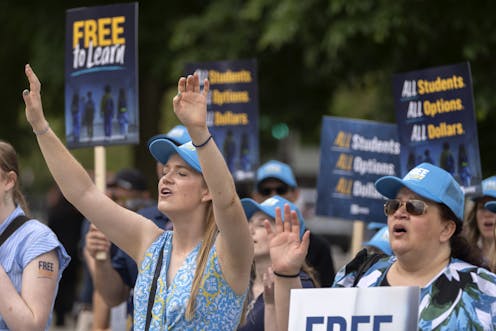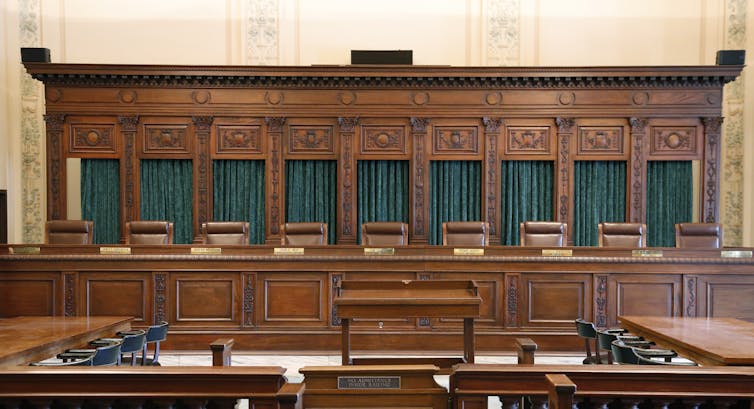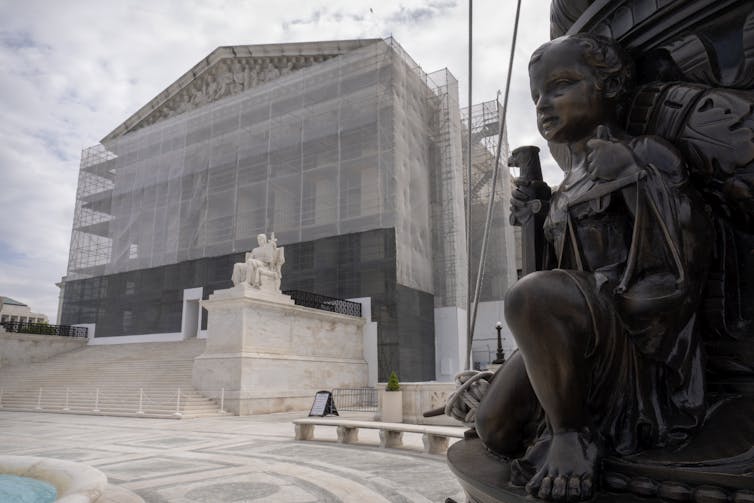Is a faith-based charter school a threat to religious freedom, or a necessity to uphold it? The weighty decision lies with the Supreme Court
- The Supreme Court is set to decide whether Oklahoma can operate its first faith-based charter school, St. Isidore, which would be funded by taxpayer dollars and offer a virtual K-12 education program run by the Roman Catholic Archdiocese of Oklahoma City and the Diocese of Tulsa.
- The case raises questions about the extent to which states can spend public funds to allow parents to enroll their children in faith-based charter schools, with supporters arguing that it’s a matter of religious freedom and opponents claiming it would lead to the establishment of government-funded religion.
- The Supreme Court will consider two key questions: whether a charter school is considered state action simply because it contracts with the state to offer a free educational option, and how the First Amendment’s religion clauses apply to faith-based charter schools.
- Five justices, including Chief Justice John Roberts, appear sympathetic to St. Isidore’s argument that excluding faith-based schools from charter programs would be unconstitutional discrimination on the basis of religion, while three justices seem skeptical of expanding state aid to faith-based schools.

As demonstrators gathered outside, the Supreme Court heard oral arguments on April 30, 2025, about whether Oklahoma can operate the nation’s first faith-based charter school. St. Isidore of Seville would be a virtual, K-12 school run by the Roman Catholic Archdiocese of Oklahoma City and the Diocese of Tulsa.
Charters are typically public schools of choice, funded by taxpayer dollars. Unlike regular public schools, they are free from most state regulations on curriculum and teacher qualifications. Until now, however, charters, like other public schools, have been secular.
The litigation over St. Isidore reveals a built-in tension in the First Amendment religion clauses, under which “Congress shall make no law respecting an establishment of religion, or prohibiting the free exercise thereof.” While the free exercise clause guarantees people the right to believe as they wish, controversy remains over what constitutes an “establishment” of religion.
Here, the specific question is the extent to which, if any, states can spend public funds to allow parents to enroll their children in a faith-based charter school. Supporters are appealing a 2024 ruling from the Supreme Court of Oklahoma, which held that a religious charter school violated state law, as well as the Oklahoma and federal constitutions.

AP Photo/Sue Ogrocki
Oklahoma Gov. Kevin Stitt, a Republican supporter of St. Isidore, has said the case “stands to be one of the most significant religious and education freedom decisions in our lifetime.”
On the other hand, the attorney for St. Isidore’s challengers – led by Oklahoma Attorney General Gentner Drummond, who blocked the school’s opening – said that a victory for St. Isidore “would result in the astounding rule that states not only may but must fund and create public religious schools, an astounding reversal from this court’s time-honored precedents.”
It remains to be seen whether a ruling in favor of St. Isidore’s would prove to be a win for religious freedom, as Stitt claimed, or a threat. Even so, as a professor focused on education law, I believe an order to continue expanding taxpayer aid to faith-based institutions looks more likely after Wednesday’s arguments, where five of the eight participating justices seemed sympathetic to St. Isidore.
The issues
The Supreme Court faces two key questions.
First, do the teachings of “a privately owned and run school constitute state action simply because it contracts with the state to offer a free educational option for interested students?” In other words, is a charter school a state actor?
Second, the justices will weigh how the First Amendment religion clauses apply to a faith-based charter school. According to the First Amendment, “Congress shall make no law respecting an establishment of religion, or prohibiting the free exercise thereof.” The question is whether Oklahoma violates the free exercise clause by excluding schools from the charter program “solely because the schools are religious.” If so, is the exclusion justified by concerns about the government “establishing” religion?
The dispute over St. Isidore comes at a time when the Supreme Court has been steadily expanding the limits of aid to faith-based schools. Starting in 2016, a trio of cases have held that states cannot deny institutions and believers generally available, taxpayer-funded aid based solely on their religions. These cases covered aid to enhance playground safety at a Missouri preschool, the right to participate in Montana’s educational tax credit program, and providing tuition assistance to Maine parents in districts lacking public secondary schools.
The other issue – the “state actor” question – essentially asks whether a state-funded school teaching Catholicism would constitute the government promoting a religion, in violation of the First Amendment’s prohibition against doing so.

AP Photo/Mark Schiefelbein
Drummond, Oklahoma’s attorney general, is also a Republican. However, he reversed his predecessor’s action allowing St. Isidore’s creation, arguing that the school “misuses the concept of religious liberty by employing it as a means to justify state-funded religion.”
In a 2024 brief to the Supreme Court, Drummond noted that Oklahoma’s “charter schools bear all of the hallmarks of a public school,” such as being entirely state-funded. During April arguments, his attorney emphasized that charters are “required to be public schools by the Congress of the United States and the legislatures of 47 states.”
If this argument prevails, it means St. Isidore is a government actor, and therefore it cannot promote any one religion over another.
The state action claim may be difficult for St. Isidore’s supporters to overcome. However, the ace in the hole is the Supreme Court’s recent trend of expanding the boundaries of government aid to faith-based schools and their students.
In fact, Chief Justice John Roberts authored the majority opinion in all three of those cases. Excluding a religious preschool “from a public benefit for which it is otherwise qualified, solely because it is a church, is odious to our Constitution all the same, and cannot stand,” he wrote in the 2016 decision.
Justice Amy Barrett, a supporter of increased aid to faith-based schools, recused herself from participating in the oral arguments, without explanation. This leaves five justices who support expanding public aid for faith-based schools: Clarence Thomas, Samuel Alito, Neil Gorsuch, Brett Kavanaugh and Roberts.
Oral arguments
During questioning, Roberts commented that St. Isidore’s creation seems like “much more comprehensive [state] involvement” with a religious organization, compared with the previous cases that expanded taxpayer aid to religious schools – leaving the door open to speculation over how he might vote. Nevertheless, he and the other four proponents of aid appeared open to St. Isidore’s argument that to exclude faith-based schools from charter programs is unconstitutional discrimination on the basis of religion.
“All the religious school is saying is don’t exclude us on account of our religion,” Kavanaugh commented. He added, “You can’t treat religious people and religious institutions and religious speech as second class in the United States.”
The remaining justices – Sonia Sotomayor, Elena Kagan and Ketanji Brown Jackson – appeared skeptical of expanding state aid to faith-based schools.
Illustrating the tensions within the First Amendment, Sotomayor remarked to the attorney representing St. Isidore, “what you’re saying is the free exercise clause trumps the essence of the establishment clause.”
Jackson said to the same attorney that St. Isidore is “not being denied a benefit that everyone else gets. It’s being denied a benefit that no one else gets, which is the ability to establish a religious public school.”
If Roberts agrees with these three justices, resulting in a 4-4 tie, the judgment of the Supreme Court of Oklahoma would remain undisturbed.
In the words of the baseball sage Yogi Berra, “it ain’t over ‘till it’s over.” The court is expected to rule near the end of its term, likely in late June.
This article includes material from an article originally published on Jan. 31, 2025.
![]()
Charles J. Russo does not work for, consult, own shares in or receive funding from any company or organization that would benefit from this article, and has disclosed no relevant affiliations beyond their academic appointment.
